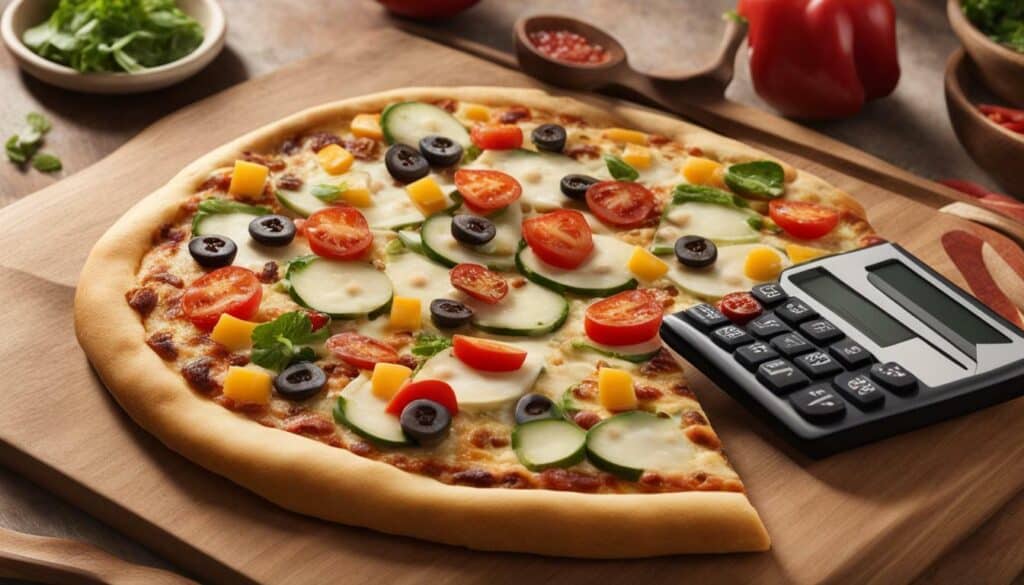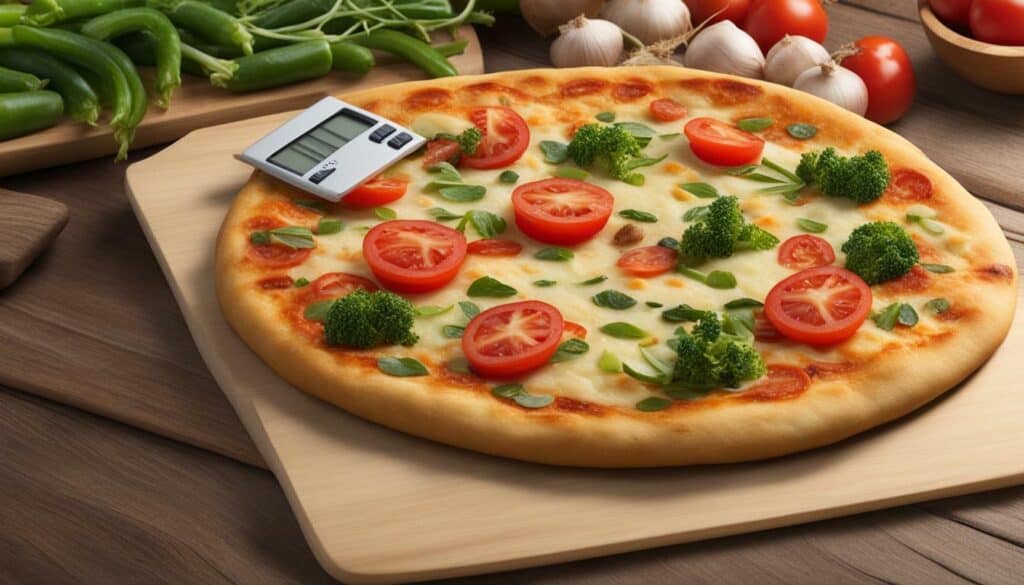Counting calories is a common practice for those looking to manage their weight and make healthier food choices. However, when it comes to flatbread, determining the accurate calorie count can be a bit more complicated than you might think.
Digestion and food preparation methods play a significant role in the calorie content of flatbread. The process of digestion can vary from person to person, making it difficult to determine exactly how many calories your body absorbs. Additionally, factors such as the cooking method and ingredients used in the preparation of flatbread can affect the calorie absorption as well.
It’s important to note that relying solely on food labels and restaurant menu calorie counts may not always provide accurate information. Sometimes, these numbers can be misleading or inaccurate, which can make it challenging for individuals who are counting calories.
Despite these potential challenges, counting calories can still be a helpful tool for weight management. It can provide an overall estimate of your daily calorie intake and help you make more informed choices about your diet. However, it’s essential to consider other factors such as nutrient content when making food choices.
- Counting calories in flatbread can be challenging due to variations in digestion and food preparation methods.
- Food labels and restaurant menu calorie counts may not always be accurate, so it’s important to be mindful of potential discrepancies.
- While counting calories can be helpful for weight management, considering nutrient content is equally important for making healthy food choices.
- Factors such as portion size, toppings, and fillings can significantly impact the overall calorie count of flatbread-based meals.
- Incorporating lean protein, colorful vegetables, and healthy fats can help create balanced and nutritious flatbread-based meals.
Factors Affecting Calorie Counts
The accuracy of calorie counts can be influenced by several factors, including digestion and food preparation methods. Digestion is a complex process that can vary from person to person. Factors such as age, metabolism, and gut health can affect how efficiently the body absorbs and utilizes calories from food.
Food preparation methods also play a role in calorie absorption. For example, cooking methods like frying or deep-frying can increase the calorie content of flatbread by adding fats and oils. On the other hand, grilling or baking can help retain more of the original calorie content.
It’s important to note that calorie counts listed on food labels and restaurant menus may not always be accurate. Various factors, such as differences in ingredient quality, portion sizes, and cooking techniques, can lead to variations in the actual calorie content of a flatbread dish.
Therefore, while counting calories can be a helpful tool for weight management, it’s essential to consider other factors as well. Nutrient content, such as protein, fiber, and healthy fats, should also be taken into account when making food choices. Choosing whole grain flatbread instead of refined options, for example, can provide more fiber and essential nutrients.
| Factors Affecting Calorie Counts | Impact on Accuracy |
|---|---|
| Digestion | Can vary from person to person |
| Food Preparation Methods | May add or reduce calorie content |
| Food Labeling | May not always be accurate |
| Nutrient Content | Consider alongside calories |
By understanding these factors and considering them in your food choices, you can make more informed decisions about your diet and ultimately work towards achieving your health goals.
The Importance of Accurate Calorie Information
It’s crucial to have access to accurate calorie information in order to make informed decisions about your dietary choices. Counting calories is a common practice for those trying to reach or maintain a healthy weight, but the accuracy of calorie counts can be questionable. Digestion is a complex process that can vary from person to person, and factors such as food preparation and cooking methods can affect calorie absorption. Additionally, food labels and restaurant menu calorie counts are not always accurate.
Despite the potential inaccuracies, counting calories can still be a helpful tool for weight management. By understanding the complexities of calorie counting, you can make more informed choices about your diet. However, it’s important to remember that calorie count alone should not be the sole determining factor in your food choices. Nutrient content is equally important to consider.
When it comes to managing your diet, it’s essential to strike a balance between calorie count and nutrient content. While low-calorie options may seem appealing for weight loss, it’s crucial to ensure that these choices still provide essential nutrients. Incorporating lean protein, colorful vegetables, and healthy fats into your flatbread-based meals can optimize the nutrient content while keeping the calorie count in check.
Ultimately, accurate calorie information serves as a helpful guide, but it’s important to consider the overall nutritional value of the food you consume. By focusing on both calorie count and nutrient content, you can make choices that support your overall health and well-being.

While calorie count is important, it’s essential to also consider the nutrient content of the flatbread you consume. Different types of flatbread can vary significantly in their nutritional profiles, so it’s worth taking a closer look at what you’re eating.
Flatbread is generally made from flour, water, and salt, but other ingredients may be added to enhance flavor and texture. Whole wheat and multigrain flatbreads are excellent choices for their higher fiber content and added nutrients. These options provide more vitamins, minerals, and antioxidants compared to their white flour counterparts.
When it comes to low-calorie options, there are alternatives available. For example, swapping traditional white flour with almond or coconut flour can significantly reduce the calorie content of your flatbread. These gluten-free options are rich in healthy fats and have a lower impact on blood sugar levels.
Benefits of Low-Calorie Flatbread
Choosing low-calorie flatbread can offer several benefits. Firstly, it allows you to enjoy your favorite bread without compromising your calorie intake. Secondly, low-calorie flatbread is often higher in fiber, which aids digestion and promotes feelings of fullness. Lastly, opting for low-calorie options can be beneficial for weight management, as it allows you to incorporate bread into your diet while still maintaining a calorie deficit.
| Flatbread Type | Calories per Serving | Protein (grams) | Carbohydrates (grams) | Fiber (grams) |
|---|---|---|---|---|
| Whole Wheat | 90 | 4 | 19 | 3 |
| Almond Flour | 80 | 3 | 5 | 2 |
| Coconut Flour | 70 | 2 | 10 | 7 |
As shown in the table above, whole wheat flatbread provides a balance of protein, carbohydrates, and fiber, making it a nutritious choice. Almond flour and coconut flour flatbread have lower calorie counts and higher fiber content, making them suitable for those looking to reduce their calorie intake while still enjoying bread. Remember to check nutritional labels for specific products, as variations in ingredients and serving sizes can affect the nutrient content.
When it comes to flatbread, focusing on both calorie count and nutrient content can help you make informed decisions that align with your dietary goals. With the wide variety of flatbread options available, you can find the perfect balance between taste and nutritional value to support your overall well-being.

There are numerous types of flatbread to choose from, each with its own calorie and nutrient composition. Whether you’re looking for a low-calorie option or a bread alternative that’s packed with nutrients, there’s a flatbread out there to suit your needs.
One popular variety is whole wheat flatbread. Made from whole wheat flour, this type of flatbread offers a good amount of fiber, which can aid in digestion and help you feel satisfied. It’s also a great source of essential vitamins and minerals, including iron and B vitamins.
If you’re looking for a gluten-free option, you might consider trying cauliflower flatbread. Made from cauliflower rice and a combination of other ingredients, such as eggs and cheese, this flatbread is low in calories and carbohydrates. It’s a great option for those following a low-carb or keto diet.
| Flatbread Type | Calories per Serving | Nutritional Benefits |
|---|---|---|
| Whole Wheat Flatbread | 100 | High in fiber and essential vitamins and minerals |
| Cauliflower Flatbread | 50 | Low in calories and carbohydrates; gluten-free |
| Sweet Potato Flatbread | 120 | Good source of antioxidants and vitamins A and C |
Another option to consider is sweet potato flatbread. Made from mashed sweet potatoes, this type of flatbread offers a unique flavor and is rich in antioxidants, as well as vitamins A and C. It’s a healthier alternative to traditional bread and can add a touch of sweetness to your meals.
When selecting flatbread, be sure to read the labels and choose options that align with your dietary goals. Consider factors such as calorie count, nutrient content, and any specific dietary restrictions. With the wide variety of flatbreads available, you can enjoy delicious and nutritious meals while managing your calorie intake.

If you’re looking to track your calorie intake from flatbread, there are several methods you can use to calculate the accurate count.
One common approach is to use an online calorie calculator specifically designed for flatbread. These calculators take into account the type of flatbread, portion size, and any additional ingredients or toppings. Simply input the details of your flatbread meal, and the calculator will provide you with an estimate of the calorie content. Keep in mind that these estimates may not be 100% accurate, but they can still provide a useful guideline.
Another method is to reference reliable sources for flatbread nutrition facts. Look for reputable websites, books, or food databases that provide detailed information on the calorie count of various types of flatbread. This can give you a more accurate estimation based on scientific analysis and testing.
It’s also important to consider the impact of toppings and fillings, as these can significantly contribute to the overall calorie content of your flatbread. For example, adding high-fat spreads or excessive amounts of cheese can dramatically increase the calorie count. By being mindful of the extras you choose to include, you can make healthier and more informed decisions.
Remember, counting calories is just one aspect of managing your diet. While it can be helpful for weight management, it’s essential to consider other factors as well. Pay attention to the nutrient content of your flatbread, opting for options that provide a good balance of carbohydrates, protein, and healthy fats. By focusing on both calories and nutrients, you can make more well-rounded choices that support your overall health and well-being.

| Flatbread Type | Calories per Serving |
|---|---|
| Whole Wheat Flatbread | 100 |
| Multigrain Flatbread | 110 |
| Gluten-Free Flatbread | 90 |
Balancing Calories and Nutrients in Flatbread-Based Meals
By combining flatbread with nutrient-dense ingredients, you can create satisfying and well-balanced meals. Whether you’re looking for a quick and easy lunch or a light dinner option, flatbread can be a versatile base that allows for endless possibilities.
When it comes to topping your flatbread, focus on incorporating a variety of colorful vegetables. These add flavor, texture, and important vitamins and minerals to your meal. Think sliced tomatoes, crisp lettuce, colorful bell peppers, and fragrant herbs. Experiment with different combinations to find your favorite flavor profiles.
To boost the protein content of your flatbread-based meal, consider adding lean protein sources such as grilled chicken, turkey, or fish. These will not only help keep you satisfied but also provide essential amino acids for muscle repair and growth. If you prefer a plant-based option, try adding tofu, tempeh, or legumes like chickpeas or black beans.
| Ingredients | Amounts |
|---|---|
| Whole wheat flatbread | 1 piece |
| Sliced tomatoes | 1/2 cup |
| Cucumber, sliced | 1/2 cup |
| Red onion, thinly sliced | 1/4 cup |
| Feta cheese, crumbled | 2 tablespoons |
| Kalamata olives, pitted | 10 olives |
| Grilled chicken breast, sliced | 4 ounces |
| Fresh basil leaves | Handful |
To add healthy fats to your flatbread, consider options like avocado slices, a drizzle of olive oil, or a spread of hummus. These additions not only add richness and flavor but also provide essential fatty acids that support brain health and protect your heart.
Remember, portion control is key. While flatbread can be a healthier alternative to traditional bread, it’s still important to be mindful of serving sizes. Pay attention to the amount of flatbread you’re using and balance it with the other ingredients to create a well-rounded meal that fits your specific dietary needs and goals.

With these tips in mind, you can enjoy delicious and nutritious flatbread-based meals that keep your taste buds happy and your body nourished. Get creative, explore various flavor combinations, and make the most of the versatility that flatbread offers. Remember, a healthy diet is about balance and moderation, so enjoy your flatbread meals in moderation as part of an overall healthy eating plan.
Flatbread Tips for Weight Management
If you’re looking to manage your weight while still enjoying flatbread, here are some helpful tips to keep in mind. Counting calories can be a useful tool, but it’s important to consider other factors as well. One key aspect to pay attention to is the nutrient content of the flatbread you choose. Opting for whole grain flatbread can provide more fiber and nutrients compared to refined options. Whole grain flatbread is a healthier choice as it offers a lower glycemic index, which can help manage blood sugar levels and promote a feeling of fullness.
Another tip is to practice portion control. While flatbread can be a great base for a variety of toppings, it’s important to be mindful of how much you’re consuming. Paying attention to serving sizes and using measuring tools can help you accurately track your calorie intake. Additionally, consider reducing the amount of high-calorie toppings such as cheeses and spreads. Instead, opt for lighter options like fresh vegetables, lean proteins, and herbs to add flavor without adding too many calories.
When it comes to cooking methods, consider healthier alternatives to frying or deep-frying your flatbread. Grilling or baking flatbread can help reduce the amount of added fats and calories, while still providing a delicious and crispy texture. Experiment with different seasonings and herbs to enhance the flavor without relying on high-calorie sauces.

In conclusion, managing your weight doesn’t mean you have to give up on flatbread. By making conscious choices and incorporating these tips into your diet, you can still enjoy flatbread while staying on track with your weight management goals. Remember to consider the nutrient content, practice portion control, and opt for healthier cooking methods. With these strategies, you can find a balance between enjoying your favorite flatbread and maintaining a healthy lifestyle.
Conclusion
Counting calories in flatbread is just one aspect of making informed dietary choices, and considering nutrient content is equally important. While calorie counts can be useful for weight management, there are several factors that can impact their accuracy. Digestion is a complex process that can vary from person to person, meaning that individuals may absorb and process calories differently. Additionally, the way flatbread is prepared and cooked can affect the absorption of calories.
It’s also important to note that food labels and restaurant menu calorie counts are not always reliable. The calorie content listed may not reflect the actual calories you’re consuming, as measurements can be imprecise and serving sizes may differ. Therefore, it’s crucial to take these numbers with a grain of salt and consider them as estimates rather than absolute values.
Despite the potential inaccuracies, counting calories can still be a helpful tool for weight management. By tracking your calorie intake, you can gain a better understanding of your overall energy balance. However, it’s important to remember that calories are not the only factor to consider when making food choices. Nutrient content is equally vital for maintaining a well-rounded, healthy diet.
When it comes to flatbread, there are various options available, each with its own nutritional profile. While some flatbread varieties may be lower in calories, others may offer more fiber or essential nutrients. Therefore, it’s crucial to consider the overall nutrient content of the flatbread you choose, rather than focusing solely on its calorie count.
In summary, counting calories in flatbread can be a valuable tool for weight management, but it’s important to consider other factors such as nutrient content. Digestion and food preparation methods can affect calorie absorption, and food labels and restaurant menu calorie counts may not always be accurate. By prioritizing a balanced diet that includes nutrient-rich options, you can make informed choices about the flatbread you consume and achieve your health goals.
FAQ
Q: Are calorie counts always accurate?
A: No, there are several factors that can affect the accuracy of calorie counts, such as individual differences in digestion and variations in food preparation methods.
Q: How do digestion and food preparation affect calorie counts?
A: Digestion is a complex process that can vary from person to person, impacting the absorption of calories. Additionally, food preparation methods can affect the calorie content of the final dish.
Q: Can I rely on food labels and restaurant menu calorie counts?
A: Not always. Food labels and restaurant menu calorie counts are not always accurate. It’s important to consider them as estimates rather than exact values.
Q: Is counting calories still helpful for weight management?
A: Yes, counting calories can be a helpful tool for weight management. However, it’s important to also consider other factors such as nutrient content when making food choices.
How Many Calories Does a Patty Melt Typically Have?
The unexpected patty melt calories count can vary depending on the ingredients and portions used. Typically, a patty melt can range from 600 to 1300 calories. Factors like cheese, sauces, bread, and serving size contribute to its overall calorie content. It’s important to be mindful of the calorie intake when indulging in this delicious sandwich.





Leave a Reply